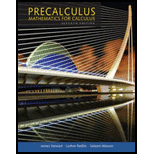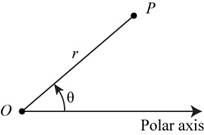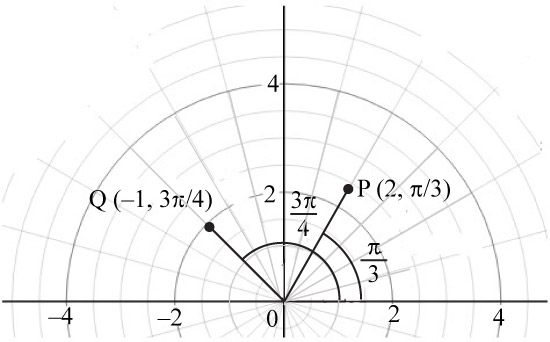
- (a) Explain the polar
coordinate system . - (b) Graph the points with polar coordinates (2, π/3) and (−1, 3π/4).
- (c) State the equations that relate the rectangular coordinates of a point to its polar coordinates.
- (d) Find rectangular coordinates for (2, π/3).
- (e) Find polar coordinates for P(−2, 2).
(a)
To describe: The polar coordinate system.
Explanation of Solution
The coordinate system
In polar coordinate system r shows the distance of the point and
In polar coordinate system take
In polar coordinate system negative r signifies that the polar coordinate
The below figure shows the polar coordinates

Figure (1)
In the above figure, the point P is r unit away adjoining with angle
(b)
To sketch: The graph of the polar coordinates.
Explanation of Solution
The below graph shows the polar coordinates

Figure (2)
In the above graph, point
(c)
To describe: The equations that relate the rectangular coordinates and polar coordinates of a point with each other.
Explanation of Solution
Use the equations
Use the equations
(d)
To find: The rectangular coordinate of the point.
Answer to Problem 1RCC
The rectangular coordinate of the point
Explanation of Solution
Given:
The value of polar coordinate is
Calculation:
Use the equations
The formula to calculate the x coordinate is,
Substitute 2 for r and
The value of the x coordinate is 1.
The formula to calculate the y coordinate is,
Substitute 2 for r and
The value of the y coordinate is
Thus, the rectangular coordinate of the point
(e)
To find: The polar coordinate of the point.
Answer to Problem 1RCC
The polar coordinate of the point
Explanation of Solution
Given:
The value of rectangular coordinate is
Calculation:
Use the equations
The formula to calculate the r is,
Substitute
The value of r is
The formula to calculate the value of
Substitute
The value of
Thus, the rectangular coordinate of the point
Want to see more full solutions like this?
Chapter 8 Solutions
Precalculus: Mathematics for Calculus (Standalone Book)
- 3. True False. If false create functions that prove it is false. Note: f(x) = g(x). a) If_lim ƒ(x) = ∞ and_lim g(x) = ∞,then_lim [ƒ(x) − g(x)] = 0 x→ 0+ x→0+ x→0+ b) If h(x) and g(x) are continuous at x = c, and if h(c) > 0 and g(c) = 0, then h(x) lim. will = x→c g(x) c) If lim f(x) = 0 and lim g(x) = 0 then lim f(x) does not exist. x-a x-a x→a g(x)arrow_forwardPls help ASAParrow_forward15. a) Consider f(x) = x-1 3x+2 and use the difference quotient to determine the simplified expression in terms of x, for the slope of any tangent to y = f(x). Also, determine the slope at x = 2. 15 b) Determine the equation of the tangent to f(x) at x = 2. Final answer in Standard Form Ax + By + C = 0, A ≥ 0, with no fractions or decimals.arrow_forward
- + Find the first five non-zero terms of the Taylor series for f(x) = sin(2x) centered at 4π. + + + ...arrow_forward+ + ... Find the first five non-zero terms of the Taylor series for f(x) centered at x = 4. = 1 x + + +arrow_forwardFind the interval and radius of convergence for the given power series. n=0 (− 1)" xn 7" (n² + 2) The series is convergent on the interval: The radius of convergence is R =arrow_forward
 Trigonometry (MindTap Course List)TrigonometryISBN:9781337278461Author:Ron LarsonPublisher:Cengage LearningAlgebra & Trigonometry with Analytic GeometryAlgebraISBN:9781133382119Author:SwokowskiPublisher:Cengage
Trigonometry (MindTap Course List)TrigonometryISBN:9781337278461Author:Ron LarsonPublisher:Cengage LearningAlgebra & Trigonometry with Analytic GeometryAlgebraISBN:9781133382119Author:SwokowskiPublisher:Cengage

